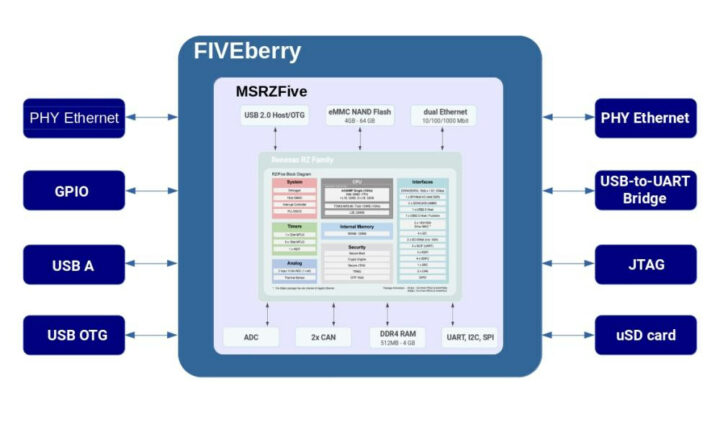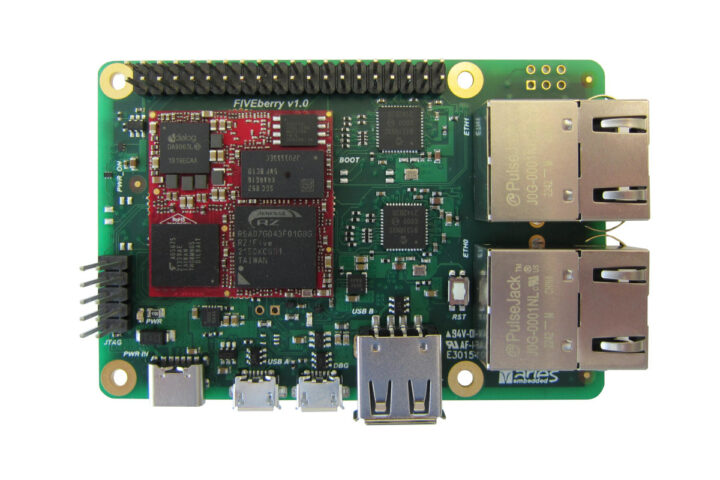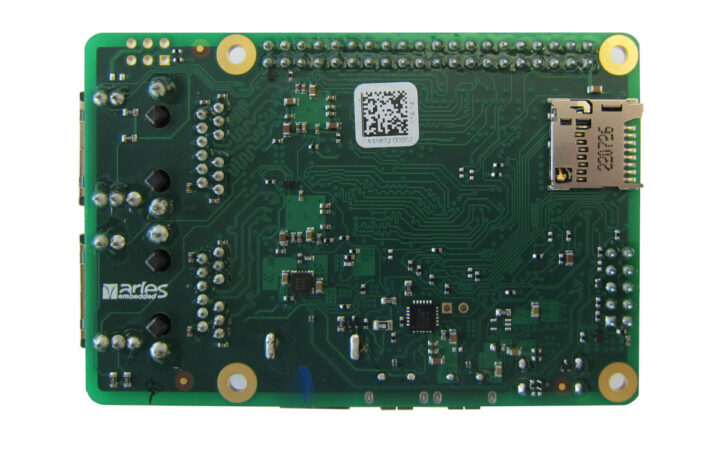ARIES Embedded has unveiled the FIVEberry 64-bit RISC-V community board for fast prototyping fitted with an OSM-compatible MSRZFive system-in-package (SiP) powered by a 1GHz Renesas RZ/Five microprocessor.
The board is equipped with a module with 512 DDR4, a 128MBit SPI NOR flash, a microSD card on the bottom of the board, two Gigabit Ethernet ports, two USB 2.0 ports, a micro USB port for serial console, and a JTAG header for further debugging, as well as a 40-pin GPIO header for expansion.
FIVEberry specifications:
- SoM – ARIES Embedded MSRZFive-A0A system-on-module
- SoC – Renesas RZ/Five R9A07G043F01GBG single-core RISC-V AX45MP processor @ to 1.0 GHz
- System Memory – 512MB DDR4 RAM
- Storage – 128Mbit SPI NOR flash
- 332 contacts as per OSM Size-S specifications
- Storage – MicroSD card slot
- Networking – 2x Gigabit Ethernet ports
- USB – 1x USB 2.0 host port, 1x micro USB 2.0 OTG port
- Expansion – 40-pin GPIO header with 2x I2C, 2x CAN bus, dual A/D converter modules
- Debugging – Micro USB port for serial console (via CP2102N), 10-pin JTAG header
- Power Supply – 5V via USB Type-C port
- Dimensions – 85 x 56mm
- Temperature Range – -25°…+85°C

ARIES Embedded will provide a Yocto Linux BSP for the board and says it’s well-suited for entry-class social infrastructure gateway control and industrial gateway control. The company highlights the system-on-module offers a parallel LCD interface, a MIPI CSI camera input, and two CAN-FD interfaces, but their description of the 40-pin GPIO header is as clear as mud with two I2C and “GPIOs”, so I’m not sure whether all those can be accessed on the GPIO header, or only a subset as listed in the specifications.
One of the reasons for the limited level of detail is that the FIVEberry RISC-V SBC will only be available in Q3 2023 at a yet-to-be-determined price. [Update: it is listed for 119.00 Euros ex VAT and shipping on the company’s store, see comments section]. More details may be found on the product page.

Jean-Luc started CNX Software in 2010 as a part-time endeavor, before quitting his job as a software engineering manager, and starting to write daily news, and reviews full time later in 2011.
Support CNX Software! Donate via cryptocurrencies, become a Patron on Patreon, or purchase goods on Amazon or Aliexpress







The price will condition its success. The specs are too limited for most applications but it can indeed serve as a tiny gateway or firewall, provided the single core at 1 GHz manages to deliver accordingly… In the ARM world, a single-core 1 GHz is the BreadBee to give a comparison. We’ll see.
Detail level is not limited. 120 EUR + Shipping and VAT, see price in the web shop: https://shop.aries-embedded.de/evaluation-kit/m/fiveberry
A detailed spec is also available there also, 2k pages of SoC docs are available from the Renesas web site.
I can only see an animation with wind turbines, a train. etc… on that page, and nothing else.
That must be a 404 page. Putting a slash at the end fixes it for me.
shop.aries-embedded.de/evaluation-kit/m/fiveberry/
thanks but too expensive for anything – maybe some enthusiasts will hit the buy button but I expect a quick EOL for it
Indeed, as I said above, the price will condition its success 🙂
120 euroes is death.
I think that everyone here on this site will agree on this 🙂
Well there was a time I bought an avr32 board for 145 plus a crazy amount of postal fees for import and VAT handling…
I never used this board for anything, as as soon as I found a use case for it it was EOL…
Just recently saw it in the basement in it’s original box.
For makers, maybe. I still expect the major target market to be industrial, which is a very different market from maker/enthusiast.
After knowing the price is looks like you are right. But the press release I received by email reads “ARIES Embedded Launches a ‘Community-Flavor-Board’ for Quick Project Entry and Fast Prototyping Based on OSM-compatible MSRZFive SiP with RZ/Five Microprocessor from Renesas”
Indeed, and I’m hardly seeing an industrial device of that price use an “exotic” ecosystem like this. I mean, if you just need a single-code 1 GHz CPU for industrial apps, just buy a beaglebone and you will have an extremely well supported device, whose architecture and ecosystem have been adapted, fixed and tested by a wide community for more than a decade. I would trust that much more for an industrial project than a $random new board with a bleeding edge arch and a proprietary BSP kernel.
Thanks